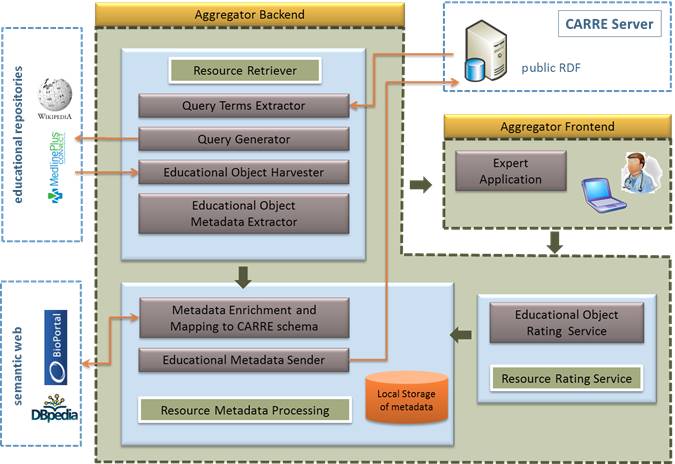
The aim of the educational resource aggregator is to harvest educational resources from 3rd party repositories, present these to the medical expert for annotation and rating, and output the results of the annotation (together with resource metadata) to the CARRE public RDF repository. So far we have designed the architecture of the aggregator.
This aggregator has a backend and a frontend. The main parts of the backend are the Resource Retriever, the Resource Rating and the Resource Metadata Processing. In short, the Resource Retriever accepts CARRE concept term for the CARRE public RDF repository and uses them to formulate queries to external 3rd party educational resource repositories. The results of this search are parsed to extract metadata. Then the retrieved results and metadata are displayed to the expert user for rating and annotation (via the aggregator front end). Rating involves expert user opinion and annotation as well as subjective measures calculating by the Educational Object Rating Module. Expert rating will involve assessment of content-keyword relevance, content accuracy and depth of coverage, while the automatic systems rating will involve Readability Test based on the Flesch-Kincaid algorithm (Kincaid JP, Fishburne RP Jr, Rogers RL, Chissom BS, 1975), and rating based on the latest modified version of the articleand number of revisions. Finally, Resource Metadata Processing involves metadata enrichment via semantic web sources (such as NCBO Bioportal medical ontologies and DBpedia) and mapping to the CARRE RDF schema so that metadata can be pushed to the CARRE public RDF repository.
The technology stack involves Javascript on both backend and frontend, all software used is licensed with compliance of the Open Source Definition. At the frontend, the AngularJSframework is used for separating the design from logic and providing rich user experience by handling all requests asynchronously. The backend environment integrates a NodeJSapplication server that handles simultaneous requests to the external educational repositories such as Wikipedia, MedlinePLUS etc. The local storage is implemented by MongoDB, a document-oriented NOSQLdatabase.
Current implementation status of the aggregator is as follows:
- The Resource retriever is implemented and extracts educational resources from MedLinePlus and Wikipedia databases via their provided APIs. The search terms are retrieved from CARRE RDF risk elements and observables.
- A first draft version of the user application has been implemented and can be accessed at http://edu.carre-project.eu/. In this version search and display of educational resources is implemented.
- The Resource Rating is under development.
- The Resource Metadata processing is partially developed: metadata enrichment via DBpedia is currently being developed, while the rest of the module’s functionality is work in progress.
Author: Nick Portokallidis (DUTH)
Date: 14 October 2014






